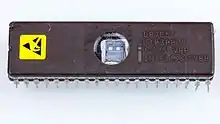CHMOS
CHMOS refers to one of a series of Intel CMOS processes developed from their HMOS process. CHMOS stands for "complementary high-performance metal-oxide-silicon.[1] It was first developed in 1981.[2]

CHMOS was used in the Intel 80C51BH, a new version of their standard MCS-51 microcontroller.[3] The chip was also used in later versions of Intel 8086, and the 80C88, which were fully static version of the Intel 8088. The Intel 80386 was made in 1.5 µm CHMOS III, and later in 1.0 µm CHMOS IV.
CHMOS III used 1.5 micron lithography, p-well processing, n-well processing, and two layers of metal.[4][5]
CHMOS III-E used for the 12.5 MHz Intel 80C186 microprocessor.[6] This technology uses 1 µm process for the EPROM.[7]
CHMOS IV (H stands for High Speed) used 1.0 µm lithography. Many versions of the Intel 80486 were made in 1.0 µm CHMOS IV. Intel uses this technology on these 80C186EB and 80C188EB embedded processors.[8]
CHMOS V used 0.8 µm lithography and 3 metal layers, and was used in later versions of the 80386, 80486, and i860.
References
- "Introducing CHMOS". Intel. Retrieved 26 September 2023.
- Gnomes, Lee; "Behind The Scenes: The Making Of The 386", Intel Corporation, Special 32-Bit Issue Solutions, November/December 1985, page 19
- Intel CHMOS Microcontroller Design Kit
- A double layer metal CHMOS III technology
- Rant, Jon; "CHMOS: Matching Process to Product", Intel Corporation, Solutions, January/February 1986, Page 17
- Ormsby, John, Editor, "New Product Focus: Components: It's Under Control With The 80C186", Intel Corporation, Microcomputer Solutions, November/December 1987, page 13
- Intel Corporation, "New Product Focus: Components: Two-and Four-Megabit EPROMs are High-Density Performers", Microcomputer Solutions, September/October 1989, page 14
- Intel Corporation, "New Product Focus: Components: New ASSP Suits Mobile Applications", Microcomputer Solutions, September/October 1990, page 11